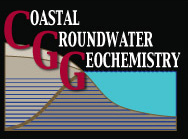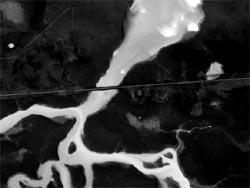Multi-scale approach to submarine groundwater discharge
Identification and quantification via remote sensing, hydrologic sampling, and geochemical tracers
Groundwater discharge to coastal waters can have a significant impact on local ecological structure because of its low salinity and, often times, high nutrient content. Proper management of coastal water resources requires that the quantity and quality of significant inputs be adequately characterized. Groundwater input to coastal waters, often termed submarine groundwater discharge (SGD), is particularly difficult to characterize because it can vary significantly through space and time. While hydrologic measurements can quantify fluid flux at specific points, the spatial variability of flow can lead to significant errors when making estimates using point data. Geochemical tracers, on the other hand, are useful in quantifying total groundwater flux to a surface water body, but are unable to identify the spatial distribution of flow. We propose to examine the utility of remote sensing technology, specifically airborne thermal imaging, in identifying key groundwater discharge locations to coastal surface water bodies. Hydrologic measurements will be collected before and after the imaging, with the sampling locations after the remote sensing work chosen based on image results. We will also collect surface water and groundwater samples for radium and dissolved nitrogen analyses. The radium samples will be used to estimate groundwater discharge to the water bodies and will be compared with the hydrologic estimates. Nitrogen samples will be used, together with the flow estimates, to determine nitrogen loading to the coastal waters. We propose to conduct the remote sensing at three locations in southeastern New England: Quonochontaug Pond in Rhode Island and Waquoit Bay and off the west coast of Truro on Cape Cod. Previous work in these three locations indicates that groundwater fluxes in these three areas vary by one to two orders of magnitude.
Funding Agencies
Many thanks to the Coastal Ocean Institute for their support of this project


